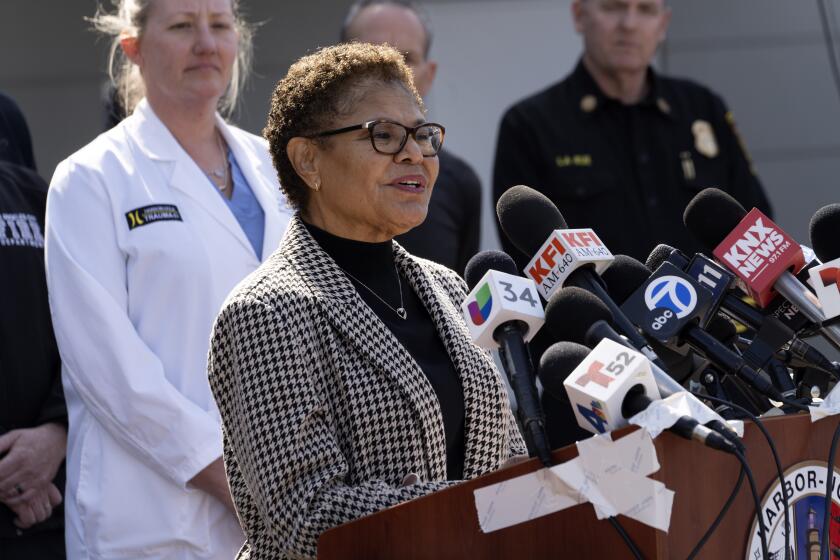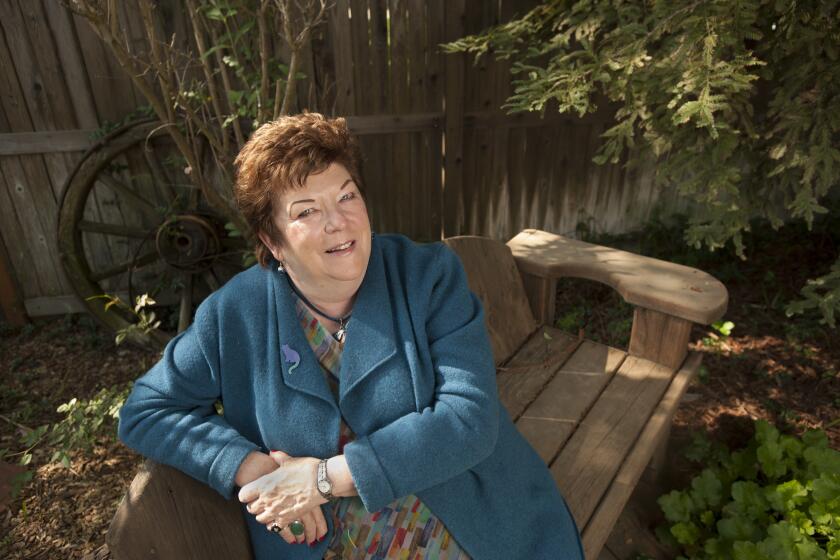Citizen measures take aim at growth
Raising the specter of rampant development and a rising tide of street-choking traffic, a group of Santa Monica residents has begun pressuring friends and neighbors to vote in November for an initiative that would limit commercial construction for 15 years.
Predictably, the Residents’ Initiative to Fight Traffic, or RIFT, has created a schism in the city, where the desire to maintain the area’s small-town scale and charms often conflicts with the need to create jobs and spur economic gains.
Santa Monica is not alone. November is shaping up to be a pivotal month for cities grappling with growth and traffic. Beverly Hills voters will weigh the merits of a proposed expansion of the Beverly Hilton that would include luxury condos and the West Coast’s first Waldorf-Astoria hotel at the busy corner of Wilshire and Santa Monica boulevards.
Redondo Beach residents, meanwhile, will mull two competing measures -- one a citizen-produced initiative and the other sponsored by the City Council -- both of which purport to give residents more say in development and land use matters.
“These [initiatives] are examples of people frustrated with the consequences and trade-offs forced by economic prosperity,” said Randall Crane, a professor at UCLA’s School of Public Affairs. Proposition 13, the 1978 measure that limited increases in the state’s property taxes, “gives local governments no real discretion over their revenues except through land use planning toward commercial, sales-tax-generating development,” he said.
“It has really distorted planning for community building, jobs and livability,” said Stephanie Pincetl, a researcher at UCLA’s Institute of the Environment.
Indeed, Proposition 13 exacerbated the long-standing pressure on elected officials to make development their priority. The constant search for revenue, prosperity and jobs -- in other words, growth -- explains in large part why Southern California looks the way it does: sprawly, congested and polluted. It also explains, Pincetl said, the Los Angeles City Council’s initial reluctance to accept Griffith J. Griffith’s 1896 gift of Griffith Park: It would take too much land away from development.
Ballot measures intended to control or manage growth typically encounter stiff opposition from the building industry and chambers of commerce. Even when measures succeed, Pincetl said, they are “virtually futile” given the region’s multiple jurisdictions and varying needs. Communities “can’t control what’s going on next door,” she said.
But community activists are determined to have a voice in matters that they say affect their quality of life.
“Developers and their friends at City Hall want you to believe that runaway commercial development is good for our city,” the measure’s backers say in their arguments for the measure. “Big developers make huge profits in our city, while residents get stuck with -- and pay for -- the huge traffic mess they create.”
Opponents -- including an odd-bedfellows alliance of businesses, developers, renters’ rights advocates, environmentalists, preservationists and the school board president -- kicked off a campaign against the initiative at a rally Wednesday. They say it would limit the city’s ability to collect revenue for schools, fire and police departments and other social services and to promote mixed-use projects and transit-oriented development with housing and shopping.
“RIFT is so full of loopholes that the damage it will do to the city will be felt for years to come,” said Terry O’Day, co-chair of the opposition campaign and executive director of Environment Now.
The measure would limit new development of offices, hotels and stores to 75,000 square feet a year, about half the current rate. The Santa Monica Coalition for a Livable City, the group behind the measure, said schools, hospitals, low-income housing and other vital community-serving projects would be exempt.
Although the measure’s supporters invoke traffic as their key motivator, the initiative does not directly propose solutions to existing traffic problems. Rather, it aims to curb future commercial development that proponents say would exacerbate conditions on the city’s already congested streets.
Jeffrey Tumlin, a transportation consultant to the city, said many of the streets are filled to capacity at peak periods. At the city’s eastern edge, freeway ramps have become bottlenecks.
For four years, Santa Monica has studied its land use and traffic circulation as part of revamping its general plan, as required by state law every 20 years. In the last year, the city has held more than two dozen workshops and hearings to review proposals and get input from the public.
On Thursday, the City Council endorsed the plan that emerged from the public process. It calls for “no net new trips” -- in other words, no increases in traffic.
The council agreed that most future development should be concentrated around transit centers -- downtown, Bergamot Station and the area around a mid-city park, all of which have been proposed as sites for Expo Line light rail stations. The idea is to reduce traffic by making it easier for residents to use public transit to run errands and go to offices, restaurants and attractions.
Under the proposed general plan, developers could earn approval to exceed height limits if the projects provided low-cost housing and “extensive” public benefits such as parks or transportation improvements.
They would also have to go through a public process after which the council would decide whether to approve any extra height.
For example, on Wilshire Boulevard, developers could extend a 32-foot limit to as high as 55 feet if they satisfied the requirements.
Now, developers can build to 55 feet only if the project is 100% low-cost housing.
Planning director Eileen Fogarty said the council agreed with the Planning Commission that the proposed plan would protect 94% of the city -- in effect, all of the residential neighborhoods -- from development that would be incompatible in character and scale. Extra height would be allowed only in a tiny portion of the city, Fogarty said.
Some council members expressed concern that the proposed plan did not go far enough to reduce heights and densities along key boulevards, including Wilshire and Santa Monica boulevards. Some longtime residents say they dread the potential for “canyonization.”
“In general, I think the heights and densities are too intense,” said Councilman Ken Genser, a former planning commissioner. On the other hand, he praised the plan’s requirement that most development above the first floor be housing.
“We’re overbuilt with offices in the city, and housing is a need,” he said.
Before the proposed plan can be adopted, it faces months of environmental review and discussion about what benefits new projects would have to provide to win approval for extra height.
Tumlin, the transportation consultant, said neither the ballot measure nor the city’s land use and traffic plan could solve the traffic problem on its own.
“To address traffic congestion,” he said, “we have to do a lot of things and all at once. . . . The important thing is to put any new development where people can get around without a car.”
--
--
(BEGIN TEXT OF INFOBOX)
Putting growth to a vote
Beverly Hills
The issue: Oasis West Realty has proposed adding a 170-room Waldorf-Astoria hotel and two new luxury residential towers with as many as 110 condos to the Beverly Hilton at Wilshire and Santa Monica boulevards. About 217 Hilton rooms would be demolished and the rest would be refurbished in the project. For the site of the former Robinsons-May store next door, the city also has approved two high-rise buildings with 235 luxury condo units. The Beverly Hills City Council narrowly approved the project, but members of the Citizens Right to Decide Committee put the issue on the ballot. The committee said the project is too high and too dense and would worsen traffic at the busy intersection. Proponents say the project would bring in revenue for schools, police, fire and other municipal services and would improve traffic flow.
--
Redondo Beach
The issue: An initiative charter amendment would require voter approval for “major” changes in land use, including a shift from public to private use and anything that would significantly increase traffic or density. Some business owners, residents and public safety groups say the measure would stifle commercial development and expose the city to lawsuits. The City Council has proposed a charter amendment of its own that would require voter approval for land use changes, including rezoning of single-family residential zones, rezoning of a low-density multifamily residential zone to a higher-density residential zone, rezoning of park or open space, or any zoning amendment that would increase the height limit on buildings in the coastal zone.
--
Santa Monica
The issue: A ballot initiative would cap commercial development for 15 years, limiting new office space, hotels and shops to 75,000 square feet a year, about half the current level. Backers say the limits would alleviate traffic congestion. Opponents say the measure would hinder the city’s ability to raise funds for schools, fire, police and other services and to promote mixed-use and transit-
oriented development.
Source: Martha Groves, Times staff writer
More to Read
Start your day right
Sign up for Essential California for news, features and recommendations from the L.A. Times and beyond in your inbox six days a week.
You may occasionally receive promotional content from the Los Angeles Times.







